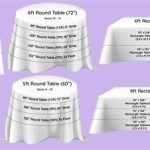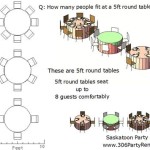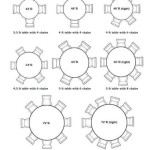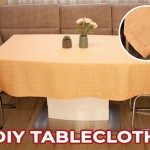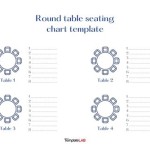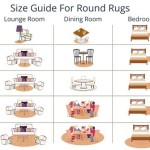How to Measure for a Round Tablecloth
Selecting the correct tablecloth for a round table involves more than simply choosing a favorite pattern or color. Accurate measurements are crucial to ensure the tablecloth fits appropriately, creating the desired aesthetic and functional effect. A tablecloth that is too short appears inadequate, while one that is too long can be impractical and even hazardous. This article provides a comprehensive guide to measuring for a round tablecloth, covering various drop lengths, measurement techniques, and factors to consider for specific situations.
Understanding the terminology associated with tablecloth sizing is the first step. Key terms include:
*Table Diameter:
The distance across the table through the center. This measurement is fundamental for determining the right size tablecloth. *Drop:
The amount the tablecloth hangs down over the edge of the table. This is a key aesthetic element and is influenced by the table's intended use. *Tablecloth Diameter:
The overall diameter of the tablecloth itself, calculated based on the table diameter and the desired drop.Accurate measurement using the correct tools is essential for preventing errors. The most reliable tool for measuring a round table is a flexible measuring tape, preferably one made of cloth or vinyl. Metal measuring tapes can be challenging to manipulate around a circular surface, leading to inaccurate results. Avoid using string or rope to measure, as these materials can stretch or sag, introducing errors. It is also important to have assistance, especially when measuring larger tables, to ensure the measuring tape remains taut and accurate.
Measuring the Table Diameter
The first step is to determine the diameter of the round table. This is the distance across the table through its center point. Locate the center point, if it is not visually apparent. Then, extend the measuring tape from one edge of the table, passing directly through the center point, to the opposite edge. Ensure the measuring tape is taut and straight. This measurement represents the table's diameter. Record this measurement accurately, as it forms the basis for calculating the required tablecloth size.
If access to the entire table surface is restricted due to its placement against a wall or furniture, partial measurements can be used. Measure as much of the diameter as possible from the accessible side. Then, carefully extend a straight edge (such as a ruler or level) from the edge of the table to the measuring tape, forming a right angle. Measure the distance from the straight edge to the wall or obstruction. Add this distance to the measured portion of the diameter, and double the result to account for the other side of the table. This will estimate the full table diameter. However, for maximum accuracy, moving the table to allow for a direct measurement is preferable.
Once the table diameter is determined, it is essential to convert the measurement to the correct units. Most tablecloth sizes are listed in inches or centimeters. If the initial measurement is taken in a different unit (e.g., feet), convert it to the appropriate unit before proceeding with further calculations.
Determining the Desired Tablecloth Drop
The drop refers to the length of the tablecloth that hangs over the edge of the table. The desired drop is mostly a matter of personal preference and the specific aesthetic being sought. However, several general guidelines can assist in making this decision. Common drop lengths include:
*Standard Drop (8-12 inches):
This is a commonly chosen drop length for everyday use. It provides an elegant appearance without being overly formal or impractical. This drop length is well-suited to dining tables used for regular meals. *Formal Drop (15-30 inches):
This drop length is appropriate for formal occasions and adds a touch of elegance and sophistication. It is often seen in banquet settings and at high-end restaurants. Note that a longer drop requires more fabric and can create a more dramatic effect. *Half Drop (6 inches or less):
This drop length is modern and casual. It's ideal for smaller tables, bistro tables, or tables where minimizing fabric is important. *Floor Length Drop:
In this case, the tablecloth extends all the way to the floor. This can be a dramatic and luxurious look, often used for special events. Care must be taken to ensure the tablecloth does not pose a tripping hazard. This style is most suitable for tables that are not frequently accessed.Consider the table's intended use when determining the desired drop. For instance, a table used for buffet-style service may benefit from a shorter drop to prevent guests from accidentally stepping on or pulling the tablecloth. Similarly, a table used by small children might require a shorter drop for safety reasons.
The height of the chairs surrounding the table can also influence the choice of drop length. A tablecloth that is too long can interfere with chair placement or make it difficult for guests to sit comfortably. If chairs have armrests, ensure sufficient clearance between the tablecloth edge and the armrests.
Visualizing the desired drop can be aided by temporarily draping a piece of fabric over the table to simulate the effect. This allows for a more informed decision about the appropriate drop length before committing to a specific tablecloth size.
Calculating the Required Tablecloth Diameter
Once the table diameter and desired drop are known, the required tablecloth diameter can be calculated. The formula is as follows:
Tablecloth Diameter = Table Diameter + (2 x Drop)
This calculation accounts for the drop on both sides of the table. For example, if the table diameter is 48 inches and the desired drop is 10 inches, the required tablecloth diameter would be:
Tablecloth Diameter = 48 inches + (2 x 10 inches) = 68 inches
This means that a 68-inch round tablecloth would be needed to achieve a 10-inch drop on a 48-inch round table.
It is essential to double-check all measurements and calculations to avoid errors. A small mistake in the initial measurement or calculation can result in a tablecloth that does not fit correctly.
When purchasing a tablecloth, compare the calculated tablecloth diameter with the available sizes offered by retailers. Tablecloths are typically sold in standard sizes, such as 60 inches, 70 inches, 90 inches, and 108 inches. Select the closest available size that is equal to or slightly larger than the calculated diameter. It is generally preferable to choose a slightly larger tablecloth rather than one that is too small, as a longer drop is usually easier to manage than an insufficient one.
In situations where a standard size is not available, consider purchasing a larger tablecloth and having it altered to the exact desired size. Alternatively, custom-made tablecloths offer the advantage of precise sizing and allow for greater control over fabric selection and design.
Special Considerations for Specific Tables
While the aforementioned steps cover the general process of measuring for a round tablecloth, certain table types and situations require special considerations.
Umbrella Tables:
Tables with a center hole for an umbrella require additional measurements. The diameter measurement remains the same, but the tablecloth will need a provision for the umbrella. This may involve a pre-cut hole with reinforced edges or a split design that allows the tablecloth to be draped around the umbrella pole. When purchasing a tablecloth for an umbrella table, ensure that the product description specifically states that it is designed for this purpose and that the hole is appropriately sized for the umbrella pole. Consider the placement of the table in relation to weather conditions that might affect the tablecloth, such as wind. A heavier fabric, or securing the tablecloth at points around the base of the table may be necessary.Folding Tables:
Folding tables often have a slightly different diameter than their listed size due to manufacturing tolerances. Measure the table diameter after it has been unfolded and properly secured. Also, be aware of any locking mechanisms or support structures that might interfere with the tablecloth drop. Ensure that the tablecloth does not impede the folding mechanism when the table is collapsed for storage.Antique Tables:
Antique tables may have irregular shapes or dimensions compared to modern tables. Measure the diameter in multiple directions to ensure accuracy. If the table is not perfectly round, use the largest diameter measurement for calculating the tablecloth size. Take extra care when handling or cleaning antique tables to avoid damaging their finish or structure.Outdoor Tables:
Tablecloths for outdoor tables should be made of durable, weather-resistant materials such as vinyl, polyester, or acrylic. These materials are resistant to fading, staining, and water damage. Consider the potential for wind when selecting the drop length. A longer drop may be more susceptible to being blown around, while a shorter drop may not provide adequate coverage. Tablecloth weights or clips can be used to secure the tablecloth and prevent it from being lifted by the wind.By meticulously following these steps and considering these specific table characteristics, the selection of an appropriately sized and aesthetically pleasing round tablecloth becomes a manageable and rewarding task.

How To Choose The Correct Size Tablecloth For Your Table

How To Measure Your Table For A Tablecloth Wipe Away Tablecloths

Round Tablecloth Size Guide Textile Town

Tablecloth Size Round

Round Tablecloth Size Guide Textile Town

Let S Talk Linens The Ultimate Guide To Table Linen Sizes Party Al Ltd Pink Hippo Blog

Table Linen For Hire Size Guide Weddings Events Special Occasion

How To Make A Round Tablecloth In My Own Style

How To Measure For A Round Tablecloth Sewing Measurements Fabric Projects

3 Ways To Choose A Tablecloth Size Wikihow
Related Posts

